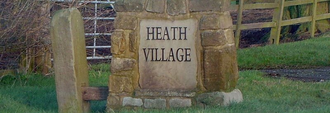
About Heath
A history
Heath was originally a simple farming village with a very long history.
Whilst the world around us has changed dramatically, the basic layout of the remaining fields, routes in and out, and the sites of buildings within this village still bear a resemblance to that of the middle of the thirteenth century. (Maps from around 1609 show the village in almost its present layout).ln fact the biggest change to the structure of the village happened before this. Two settlements known as Lunt, Lund or Lound which means a grove or clearing in a wood, were noted in the Domesday Book of 1086. These settlements, one to the east and the other to the west, were re-sited between the late twelfth and mid thirteenth century on “Le Hethe”. Although this name was noted in 1257, ecclesiastical circles continued to refer to Lunt into the sixteenth century.
ln 1086 WiIIiam the Conqueror presented the manor to Roger de Poitou as a reward for the support of his father, Earl Roger de Montgomery II, at the Battle of Hastings. ln 1088 the manor was given to the monastery of Geronden in Leicestershire by Robert de Ferrers, and was farmed by Cistercian monks for the following 400 years. During the reign of Henry Vlll, following the Dissolution of the Monasteries sometime between 1536 and 1540, the manor passed to the Savage family of Stainsby. On 17th January 1593, Edward Savage sold the manor of Heath, along with Stainsby and Owlcotes (or Oldcotes) to Elizabeth Shrewsbury, better known as Bess of Hardwick, for £3416.
Through her second marriage to Sir William Cavendish Bess had already acquired the Estate, and had built the first house at Chatsworth. On her death, the Chatsworth Estate, along with Heath, was inherited by her second son William Cavendish, who was to become the first Earl of Devonshire, and eventually her great-great grandson, the fourth Earl and first Duke of Devonshire. Heath has remained part of the Estate of the Dukes of Devonshire since, although several individual properties have been sold off over the last 50 years.
In the village, there are two buildings listed as Grade II, meaning they are of special archaeological and historical interest. There is a thatched cottage located near to the entrance of the former Heath Comprehensive School. The second building is the remains of the original 12th-century church, which is separated from the village by the dual carriageway.
The village had a railway station on the Great Central Railway, which partly followed the route taken by the A617. Both the line and the station closed in the 1960s as part of the 'Beeching axe'.
Modern day Heath
Some of the village continues to be owned by the Chatsworth Estate, with the traditional "Chatsworth Blue" doors and window frames signifying the properties leased from the estate. The original dwellings are constructed mainly of the pale wheat-coloured local sand-stone, whilst the more modern constructions, and the numerous barn and farm conversions, have all been blended sympathetically together in a mix of ancient and modern that merited the villages’ official designation as a Conservation Area in May 1977.
The area has always been rich in woodland, and Heath has become noted for the wonderful avenue of Lime Trees which stand flanking the Main Street and add much beauty to the village. Indeed, many of the properties bear testimony to this verdant heritage with names like Lime Tree House, Hawthorn House, The Hollies, The Orchard, and a string of cottages prefixed with names like Fern, Chestnut, Beech, Hazel, Oak Tree and Laurel.
Christian, Countess of Devonshire, founded Heath’s first school in 1685, and it still stands on the High Street. But like a number of other former public buildings in the village, it has been tastefully converted into a private dwelling house. Across the High Street, the former Reading Rooms have become a private house, whilst directly opposite stands Dragon Cottage, formerly the old George & Dragon Inn. Alongside on the roadside verge, stands another relic from a past age, an old stone horse-trough bearing the inscription `George & Dragon 1894’.
The Old Forge, now a private dwelling standing next to the Post Office in the centre of the village, is another converted reminder from the past, and is one of two forges that once operated here, thus giving a clue to the area’s agricultural heritage.
Economy
The village of Heath once hosted a blacksmith, a cobbler, three public houses and a Post Office. Only The Elm Tree public house and a garage & petrol station on the outskirts of the village now remain. Many of the revamped private residences retain the names of the previous existence, such as The Old Reading Room and Smithy Cottage.
The village is now home to a mixture of retired people, young families, local tradespeople and small businesses, and commuters who travel to Chesterfield, Sheffield, Derby, Nottingham and beyond.
